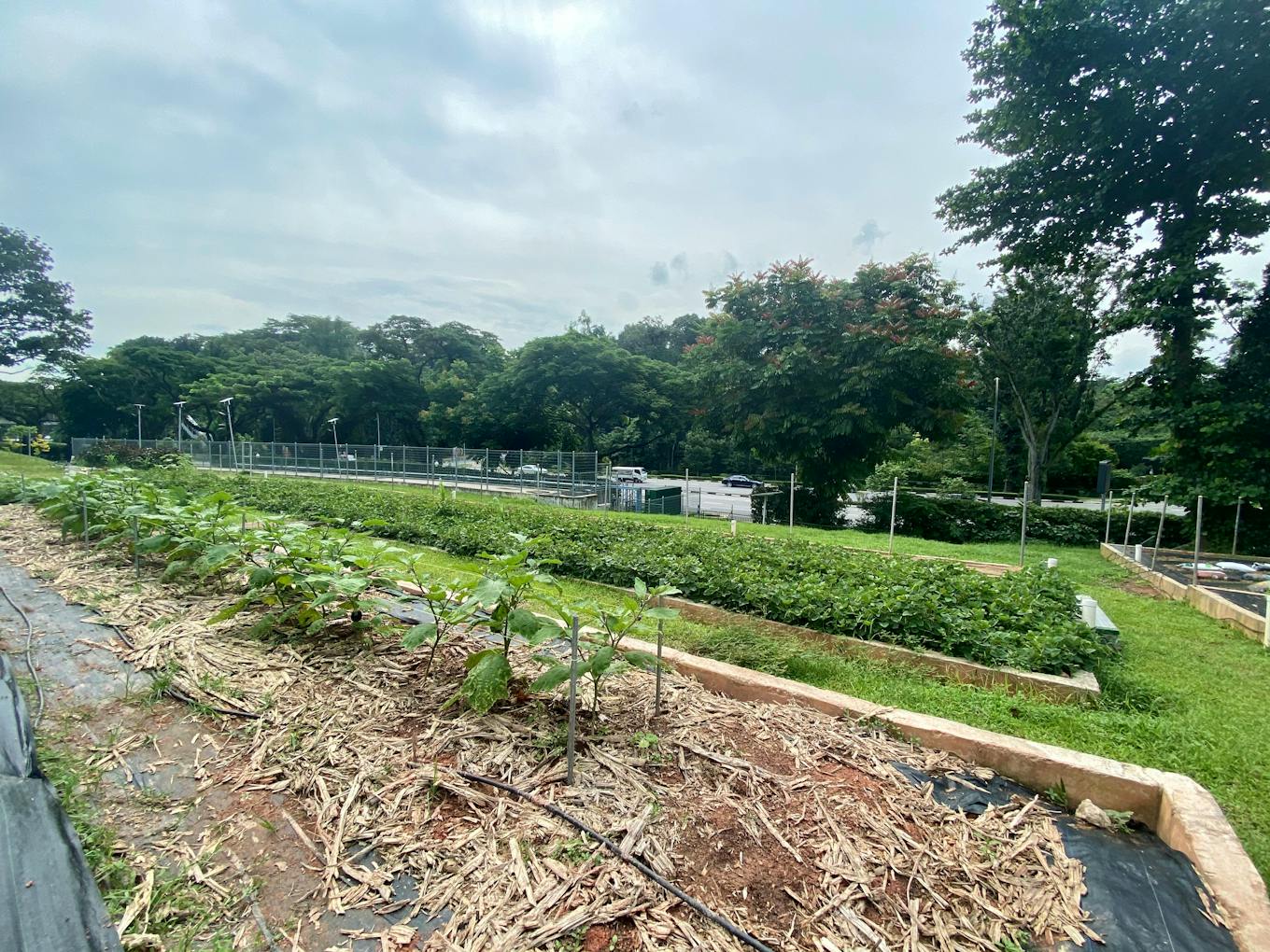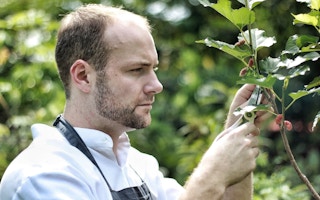Oliver Truesdale Jutras is head chef at Open Farm Community, a restaurant that aims to use produce grown on urban farms to bring farm-to-table dining to Singapore.
To continue reading, subscribe to Eco‑Business.
There's something for everyone. We offer a range of subscription plans.
- Access our stories and receive our Insights Weekly newsletter with the free EB Member plan.
- Unlock unlimited access to our content and archive with EB Circle.
- Publish your content with EB Premium.
He trained at The Pacific Institute of Culinary Art in Vancouver before working in restaurants in major cities including Canadian capital Ottawa and Sydney in Australia alongside leading voices for sustainable seafood and support-local campaigns like Robert Clark and John Taylor.
Together with his partner and sous-chef, Phoebe, they started pop-up restaurants across the globe. In recent years they’ve settled in Singapore, where they hope they can support urban food systems and ethical supply chains while nurturing a community of city farmers.

Newly-opened farm adjacent to the food outlet’s dining area. Image: Rachel Teng
Under their direction, the open-concept food outlet harvests herbs, spices, vegetables, and fruits, at their on-site garden and farm. Every other ingredient is sourced as locally and sustainably as possible, including natural wines that eliminate single-use glass bottles, or responsibly farmed and ethically-waged rice.
Here, Oliver shares his typical working day, while trying to navigate the ‘new normal’ of Covid-19 dine-in restrictions.
8:00am: I wake up at around this time, which is late compared to others, though as a chef I end my shift later than the average person as well.
10:30am: I reach the restaurant. The first things I do are write the tasting menu for the night and check on the kitchen, servers [waiters], and farmers to make sure everything is okay. If the farmers or kitchen staff say they have a surplus of certain foods, I will incorporate them into the tasting menu for the night.
Here, we work only with sustainable proteins and thus try to use them as meaningfully as possible. For instance, we get our fish from local small-scale fisheries like Tiberias Harvest off the coast of Pulau Ubin.
Since our supply of fish depends highly on the day’s catch, we often don’t get to choose the type or quantity of fish we get. Today we have extra barramundi, which we’ll pair up with a different garnish than yesterday, harvested from the farm or garden. We adapt our menu to the changing supply of produce, but still have a static menu based on regular produce.
Instead of relying exclusively on a select few fish species year-round, this ensures a consumption pattern that is more in balance with marine ecosystems and gives time for fish populations to regenerate.
11:45am: I conduct a daily service briefing with my staff, where we go through any changes in the lunch menu and the specials of the day. We switch up our lunch menu quite a bit (every three to four days). It’s usually the time where we align with our servers on exactly which dishes to push for the day and their market pricing. Our servers definitely don’t offer recommendations purely based on what’s good, instead they incorporate what’s going to be best for the restaurant as a whole. (Of course, the hope is that everything is good!)
Since Covid-19, we’ve been doing a lot of food preservation. While I typically avoid manipulating my ingredients too much to retain their nutritional value (the difference can be up to 80 per cent), preservation processes like pickling and freezing are actually key to extending shelf life and minimising food waste and costs on short notice. We have currently been preserving all our excess watermelons on hand since the latest Covid-19 restrictions, and these are going to sell well as watermelon rind on our specials menu when people are allowed to dine in again.
Coming from North America where people tend to be wary and think of specials as dishes that restaurants are trying to get rid of, I’ve been astonished that the public response to specials is pretty insane here — perhaps because it sounds exclusive. If we put the same dish on the specials menu instead of the normal menu, the response may be twice as good. We have since adapted to the local mentality, and specials now tend to be actually something special that we’ve got in small quantities. This can be really good for testing out the response for new dishes.
12 noon: Our lunch service starts and we get to cooking; it’s a two-hour frenzy. At around 12:30pm we start getting a lot of orders.
We compost our kitchen byproducts, which took quite a bit of trial and error. We tried composting underground, but that takes much longer to ferment due to the lack of oxygen (up to two years). The Singapore Land Authority (SLA) also has sanitation restrictions against installing composting containers on-site in case it attracts vermin and other pests.
Our volunteer community was really helpful in finding ways around these issues. For instance, we had a Singapore airlines pilot reach out to us during phase 2 [of Covid-19 restrictions last July]. He’s a compost fanatic who helped kickstart our compost programme for the rest of our volunteers and farmers. Now, we have a full-fledged compost system with aerated tubes installed under the soil to help with decomposition.
2:30pm: We end lunch service and do a full clean down of the kitchen, and start resuming preparations for dinner services by 3pm. One of our chefs will also be cooking our staff meal during this time.
4:30pm: Staff meal and break time. Sometimes, staff meal is “food waste” — byproducts that can still be turned into dishes of our own. We currently serve this chicken salad dish, where sometimes we’ll end up with too many chicken carcasses to even reuse for the master stock. We will then make chicken soup out of them for our staff.
Over the circuit breaker, we’ve actually been working on a more creative staff meal structure. In countries like Australia, it’s a huge thing for cooks to use restaurant staff meals as opportunities for experimentation. One of our dishes, the drunken chicken, actually came from a staff meal one of our chefs prepared. It’s hard to find time to develop new recipes here since we operate seven days a week, so this is a really efficient way for us to keep our menu and daily operations interesting.
5:30pm: Staff meal ends and everybody is back in the kitchen. Dinner service preparations are probably still ongoing at this point. At 5:45pm, we will do another briefing at the front-of-house, which will usually cover the tasting menu for the night, and any concerns from lunch brought up by the hostess.

Open Farm Community is one of the first and few restaurant outlets in Singapore which serves 100 per cent natural, organic, or biodynamic wines. Image: Open Farm Community.
9:30pm: Last orders stream in, so diners have an hour to finish their drinks or leave. Typically, my kitchen staff is out of here by 10pm. Those in the food and beverage industry would know that these are really good hours. I’m quite serious about keeping to working hours because I believe people should be paid overtime if they work past their scheduled hours.
11:30pm: The front-of-house staff, Phoebe and I usually leave around this time after finishing up the paperwork for the day.
12 midnight: I reach home. I typically don’t do much activity at night. If I’m doing something active, it’s usually in the morning. Recently, though, I got into a video game called Disco Elysium. It’s got quite a mature, “noir film” setting and lots of grungy edges; the first I’ve played in a long time.












